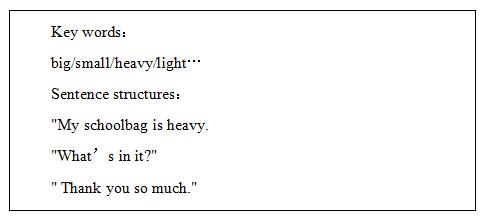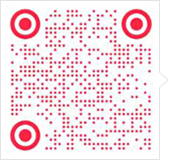
http://jiangxi.hteacher.net 2017-06-01 14:22 江西教师招聘 [您的教师考试网]

1.What’s in the schoolbag?(说课)
Good morning, everyone.I am the No.2 candidate interviewed for primary school teacher.Now I will say something about my lesson.
1.Analysis of teaching material
Today I’m going to talk about Part B of Unit 2, PEP Primary English, Book 3. This lesson includes two parts: Let’s talk and let’s practice. In section 1, it mainly deals with the dialogue about “What’s in the schoolbag?” and the answers. And in section 2, it provides a real situation for the Ss to practice the pattern: How many +n.(pl.)+ do you have? And the answer: I have 2,3 +n.(pl.)
The teaching aims are:
Aims on the knowledge:
(1) To enable the Ss to understand and speak: “My schoolbag is heavy. What’s in it? Thank you so much.” Make sure that Ss can use these sentences in real situations.
(2) To help Ss to finish the survey.
(3) Let Ss finish the assessment of “Let’s check” in this unit.
Aims on the abilities:
(1) To develop Ss’ abilities of listening and speaking.
(2) To train the Ss’ ability of working in groups.
(3) To foster Ss’ abilities of communication and their innovation.
Aims on the emotion:
(1) To foster Ss consciousness of good co-operation and proper competition.
(2) To lead Ss to show their loveliness to the poor.
Key-points of this lesson are:
(1) To help Ss ask and answer the question: What’s in it?
(2) To enable Ss to study in groups and co-operate skillfully.
(3) To develop Ss’ interest in English.
Difficult points in this lesson are:
(1) To help the Ss ask and answer the question “What’s in it?” and make sure they can use the plural nouns correctly.
(2) To finish the survey by themselves.
2.Analysis of students
Our boys and girls are exposed to English for the first time, so it is very important to develop their keen interest in English. It is not a long history that English is as a subject in primary school in our country and the main instructional aims of teaching English in primary school is to cultivate pupils’ basic abilities of their listening and speaking and their good sense of the English language. For the students who get to know and learn English for such a short time, they are shy to show and eager to learn. So we need know them quiet well to operate the appropriate teaching methods and learning methods.
3.Teaching methods
As we all know: the main instructional aims of learning English in primary school is to cultivate pupils’ basic abilities of listening and speaking and their good sense of the English language. So in this lesson I’ll mainly use “Task-based” teaching method. That is to say, I will let the Ss learn in real situations, finish a task by making a survey to help the Ss to get a better understanding of the key structure of the dialogue. I will arrange four kinds of activities: singing, guessing game, finishing a survey and having a competition. And in this lesson a recorder, CAI, school things and a printed form will be needed. Students should prepare some school things.
4.Learning methods
I mainly use researching learning method together with cooperative learning method in this lesson.
5.Teaching procedures
I’ll finish this lesson in five steps.
Step 1. Warm-up and preview
(1) Free talk between T and Ss about things in the classroom.
(2) Sing the song together: Books and pencils.
(3) Do some TPR, for example: Show me your English book. Show me your crayon.
(4) Review the numbers by asking: “How many crayons do you have?”
Purpose: It is important to form a better English learning surrounding for the Ss by singing and doing some total physical response and at the same time it provides situations to review learned knowledge for the next step.
Step 2. Presentation
Now I’ll mainly talk about this step.
(1) Present the pattern: “My schoolbag is heavy.” “What’s in it?.”
A. Show a bag and say: “Look! I have a bag.” Carry it and say: “Oh, it is heavy. My schoolbag is heavy.” Help the Ss understand the meaning with the help of my body language. Then lead the Ss to read the sentence. Make sure they can say it correctly.
B. T: My schoolbag is heavy.
Open the bag and say: “What’s in it? What’s in my schoolbag?”
Take out a Chinese book. Then do the action again. Let the Ss read the sentence.
(2)Play a guessing game. Divide the whole class into four groups to have a competition.
Let them guess: What’s in the bag? How many? Purpose: To present the key structures one by one is much easier for the Ss to learn and grasp the meanings. Proper competition can arouse the Ss’ interest in English learning.
(3) With the help of the CAI to present the dialogue. Set a situation to help Ss understand: Two Ss are coming. One girl is carrying a heavy bag on her back. They are talking.
Girl: My schoolbag is heavy.
Boy: What’s in it?
Girl: 20 story-books, 32 pencil, 9 rulers, 12 crayons and 30 picture-books. Etc.
Boy: What will you do?
Girl: They are for the poor.
Boy: Great! I’ll bring some school things too.
The boy comes back home and puts a lot of things into the bag. Then he goes to school again and gives them to a teacher. While he is taking them out, he is counting the numbers of all things. The teacher says: Thank you soooooooo much.
(4) Mention that we should take care of the poor.
(5)Play the cassette. Let the Ss listen and imitate the dialogue.
Pay attention to their pronunciation and intonation. Purpose: CAI can provide a real situation for the Ss to understand the dialogue and the relationships between people better. Tell the Ss we should show our loveliness to the Ss.
Step 3. Practice
Divide Ss into groups of six children. Each one would finish the printed form by asking and answering: How many storybooks do you have? Find out which group finishes faster. Story books picture-books sharpeners crayons pencils erasers pencil-cases rulers Chen Jie 8 24 3 32 26 4 1 3 Purpose: Task-based teaching method is used here to develop Ss’ ability of communication and also their ability of co-operation will be well trained.
Step 4. Assessment
Help Ss finish “Let’s check” of this unit and workbook.
Purpose: To check the knowledge Ss have learned in this period.
Step 5. Add-activity
(1)Let Ss tell each other how many school things they have after class. Tell their parents how many school things they have at home.
(2)Take care of everything they have.Purpose: Revision is so important that Ss should speak English as much as they as in class or after class. It is necessary for the Ss to do some extensive exercises after class to consolidate the knowledge they learned.
6. Blackboard design
In order to make the lesson much clearer, the blackboard design are as follow:

2.Unit 4 What can you do?(说课)
Good morning ,honorable judges. It’s my great pleasure to be here sharing my lesson. I'm candidate NO.7 applying for primary school English teacher. Today my topic is housework. My presentation mainly contains the following aspects: Analysis of teaching material, analysis of student, assessment of performance and teaching procedure.
First of all, I want to introduce the teaching material.
Today's lesson is the 4th period of Unit 4, Book 5, PEP. It mainly talks about the housework and some related sentences patterns, like What can you do? Can you make the bed? The content is close to the students’ real life and familiar to them, so they can find interests in learning it. Therefore, learning it well will do a great help not only to the following study of the unit, but also to the whole learning of English.
So what’s the real situation of students in Grade 5 ?
Based on the observation, students have already learned about 300 words and 30 expressions. The students are very active and good at in memorizing and imitating, but their ability in using the language remains to be improved. In order to overcome the difficulties , I’ll assign some tasks to them.
Given the analysis of teaching material and students , the teaching objectives are as follow:
A) Knowledge Objectives
Students are able to understand and speak the sentence patterns What can you do? Can you make the bed? Yes ,I can.No , I can’t.
B) Ability Objectives
Students can use the sentence structure in a conversation.
That’s to say, to develop the skills of listening and speaking in applying them flexibly into different situations.
C) Moral Objectives
Students will have the consciousness of communication and caring others.
On account of the above analysis,the important point is to use the expressions in a sentence. As to the difficult point is grasping the main idea of the dialogue.The students will also find it hard to communicate with others with a good logic and well-organized language.
All right, teaching background has been analyzed above, then I will talk about the assessment of performance. Base on the new curriculum standard, I’ll give formative assessment to students’ performance. Meanwhile, students will have mutual rating in the activities which can give them a good opportunity to practice their individual study.
For example, in the Practice part, I’ll arrange students to act out the Read and Write part in groups. The best group can get 5 stars. At the same time, I give them timely praise such as: Excellent! Well done! I’m so proud of you! No matter their performances are good or not,they can be encouraged.
As is know to all, teaching plan is the core of a lesson. I’ll divide my teaching plan into 3 parts: Teaching method Teaching aids and Teaching procedure.
During this lesson, I’ll mainly use “Task-based” language teaching approach, “Communicative” teaching method and situational approach. I’ll assign some tasks to be accomplished by students themselves-- namely, “learning by using and leaning for using”. So the whole teaching procedure will focus on students’ autonomous learning, cooperative learning and inquiry learning.
In my lesson, I’ll use the multimedia computer, power point, a tape recorder and some pictures etc. to make the input comprehensible and reasonable, and also make my teaching lively and interesting.
Now, time for me to express my ideas of teaching procedure. It consists of 7 steps.
Step1:Warming up
I’ll begin my class by playing the tape about Let’s Chant part and ask students repeat after the tape.
As we all know, “Well begun, half done.” An English song related to the topic will not only warm the class up at once, but also make good preparation for the lead-in and presentation.
Step 2: Leading in
To lead in the new lesson, I will show students some phrase cards and ask students: Can you do house work? What can you do?
Students could say: Yes, I can. I can wash the clothes. I can set the table. and so on. In this way, students will review what they have learned before and their attention will be attracted immediately.
Step 3: Presentation
In this part, I’ll arrange students to watch a cartoon about Read and Write Part. Before watching, I will ask two questions:
What can robot do? What can’t robot do?
Students are going to fill in the blanks after watching. The answers will be written on the blackboard. Then students will repeat the conversation of the cartoon several times.
To present the section A by cartoon is much easier for students to learn and grasp the meaning, which could provide students with a real situation with its sound and picture.
Step 4: Practice
Now, time for students to practice.I design two activities to help students grasp what they have learned better:
Activity 1: A train game
Students will play the game in teams: The first student in each team is the leader, who begins the game by asking the next member:What can you do?Can you make the bed? The next one is supposed to respond:Yes, I can.I can make the bed. During the game, teacher will walk around the classroom and observe. Stickers will be given to anyone whose respond is the fastest.
Activity 2: Role playing
Students in groups will firstly have 5 minutes to try to rewrite the dialogue.Then I’ll invite 4 groups to go to the platform and act out their conversation.
Task-based teaching method is used here to develop Ss’ ability of communication and their ability of co-operation will be well trained. And I think proper competition can arouse Ss’ interests in English learning.
Step 5: Consolidation
In task 1, I’ll first let the Ss do a survey of what their classmates’CAN DO or CAN’T DO and they make a report like: I have a friend Tom. Tom can do the dishes and use the computer, he can’t wash the clothes. But Amy can .
Then, just as Herbart’s saying goes teaching should always be instructive.
So in task 2 , I’ll play a video for Ss about a day of mother Students will see what a mother do during a day and have a brainstorm: what can we do for your mother?
All the tasks above are designed for this step to output the language knowledge. If Ss can finish the last task well, Ss will have a better understanding of loving others.
Step 6: Summary
Students will summarize the knowledge they have learned today, as a teacher, I will make necessary supplements.
Step 7: Homework
Students are supposed to make a survey: to describe what their family members can do and use the information to make a family album.
Homework is a necessary supplement in that students should practice English as much as they can in class and after class, especially their implementing ability should be promoted through individualized homework.
Well, here, I want to talk someting about my blackboard design. On the top of the blackboard, I’ll write the title of this Unit. On the left, I’ll write the key words and phrases of this lesson. In the middle, I’ll write the key structure of this lesson. This part is designed for the PK results. This is left for some other things.
At last,I want to talk about the my presentation.
My bright spot of this lesson lies in:
The active implementation of task-based Teaching approach.Tasks are formed basic to tougher, linked with each other.Through all this activities like short play, students can be more cooperative.
1.五上 Unit 3 What would you like?(试讲)
Let’s spell
Good morning, Boys and girls! welcome to our new class!Are you happy? Yes!Me too. Before our new class, I will invite a girl to you. Look at the picture on the big screen. Her name is Lucy. Today Lucy went to a big farm. Can you guess what she can see on the farm? Who can guess? Tom, please! You said she can see animals. AH,She may see many animals. Anything else? Rachel, please. You said she may see many plants. Well done! Some of you guessed she can see animals, and some guessed she can see plants. Now, let’s see what she saw on the farm together, ok?
Boys and girls, look at the screen! What’s this? It’s a big farm. What can you see on it? The girl in red, please! You said you can see a cow. A cow! Cow, cow, cow. [aʊ],[aʊ]. Cow, cow, cow. Is the cow big? Yes, the cow is very big. Anything else? What can you see on the farm? OK, the boy over there. You said you can see a flower. Yes, it’s a flower. Everybody, read after me, flower, flower. Ok, you please. Flower, [aʊ],[aʊ], try again, very good! Is it a beautiful flower? Yes, it’s a very beautiful flower! Everybody, what’s this? It’s a tomato. What color is it? It’s yellow. Yellow, yellow, [əʊ], [əʊ].Read after me, [əʊ], [əʊ]. Yellow, yellow, yellow! You did a good job! Boys and girls, look at this! What’s this? Yes, It’s a snail. Is the snail slow or fast? Yes, it’s very slow. Slow, slow. [əʊ], [əʊ].Read after me, [əʊ], [əʊ]. Slow, slow. One by one, please. Well done! Pretty good! Quite good!
Boys and girls, look at the blackboard. What are they? Yes, they are houses. And here are four words: flower, cow, tomato and slow. Now, let’s play a finding game to help the four words find their home, ok? I will divide you into groups of four to discuss. Then I will invite one of you cone to the front to help them find their houses. You have 3 minutes to prepare. Are you clear?Great! …Time’s up. Which group wants to try? I believe you can. Ok, this group. Who will come to the front? Wow, John, please. Come here!… Thank you! Do you agree with him? Yes, excellent! Flower and cow are in a house. Yellow and slow are in a house. Do you know why? Let’ read them, together. [aʊ],[aʊ], flower, cow. [əʊ], [əʊ], yellow, slow. Excellent!
Now let’s do “listen, circle and say”. I will read and you circle the different one. Got it? Yes! Are you ready? The second one: how, flower, window. The third one: now, snowy, slow. Did you finish? Fantastic! Who wants to show your answer? You, please. The second one is window. Excellent! Who can answer the third one? Ok, you please! You chooses snowy? I’ m sorry. Would you like to try again? Good!Listen carefully! Now, snowy, slow. Which one is different from others? Great! Everybody, slow, [əʊ], [əʊ], slow. The others are [aʊ],[aʊ], now, snowy.
Boys and girls, look at the blackboard! Here are three sentences. I will read the sentences and you write the missing words. Are you clear? Yes, very good! Who want to write the missing words on the blackboard? Any volunteers? Good job! Tom, please! You are so brave! Anyone else? Wow, Lily and John! Thank you! Everybody, are you ready? Yes! I see a yellow flower. I see a yellow flower. Slow done. Slow done. How about tomorrow? How about tomorrow? Now we can see Tom and Lily have finished. John, come on! We believe you can. Listen again ok? How about tomorrow? Yes, quite good! Let’s check the answer together! I see a yellow flower. Flower. F-l-o-w-e-r. Right! Slow done. Slow done. Slow, s-l-o-w, great! How about tomorrow? Tomorrow, t-o-m-o-r-r-o-w. Wonderful! Let’s clap your hands for them!
Boys and girls,what have you learnt today? Yes, we learnt the pronunciation of“ow”. And, we learnt many words with“ow”and their difference. Good job! Today, we see what there are on the farm from our friend Lucy. We have a happy time. Right? Yes! I hope we can always learn from Lucy to share our happy time with our classmates and our friends. Do you also think so? Yes! Good children!
We learnt so many words with “ow”, today’s homework is to read the words we learnt today with your partners. Are you clear? Yes! Ok, Today’s class is over. Bye-bye!See you tomorrow!
2.Unit 5 My new room(试讲)
Good afternoon, dear judges. I’m No.3 candidate, applying for primary school English teacher. It’s my great honor to stand here. Now I’ll begin my demo class.
Warming up/Leading-in
Good afternoon, boys and girls, how are you toady? I’m fine, too, thank you! So, at first, let’s do a chant together, okay, stand up, are you ready? What would you like? What would you like? I like swimming, swimming, swimming, swimming. What would you like? What would you like? I like dancing, dancing, dancing, dancing. What would you like? What would you like? I like jumping, jumping, jumping! Nice work, so I want to show you my photos, look at the screen, wow, it’s beautiful, yes? It’s my new room, I like it very much. Welcome to my new room! Well, what can you see in my new room? Windows, yes, bed, desk, books, and flowers, you look it so carefully, any else?
Presentation
Look here, what’s this, yes, but we should say it mirror in English, mirror, mirror, mirror, how about this one? Curtain, follow me, curtain, curtain, look at there, this is curtain, clear? Next, this one, I put my clothes in it, very good, you are right, it’s closet, closet, closet, and this one, we can feel so cool in summer, we call it air-conditioner, air-, air-, conditioner, conditioner, air- conditioner, air-conditioner. Now, when I say curtain(low voice), you will say curtain(loudly), clear, boys first, mirror, mirror, girls, closet, closet, boys, air-conditioner, air-conditioner, girls, air-conditioner, air-conditioner, well done!
This is my new room, our old friends, Sarah has her own new room too, and let’s visit it together, okay? Are you ready, listen and look. Okay, what’s Sarah’s new room like? Is it big or small? What can you see in her new room? Good, you please, ahh, a big closet, yes or no?( click the ppt ) Yes! Very good, sit down, please. Anymore? You, please, air-conditioner, really? Yes, you are right, thank you, sit down, please. More? You, please, flowers, are there any flowers? Sarah doesn’t say it, maybe here it is, maybe not, but I think there maybe, flowers are so beautiful! What? You, please, Mirror? Curtains? let me see, great, a new mirror, and curtains, what color? Blue curtains, my favorite color, wonderful, sit down, please, thank you. Well, in Sarah’s new room, there is a big closet, yes, a new air-conditioner, and a new mirror, read after me, mirror, mirror.
Practice & Consolidation
Do you like Sarah’s new room? Yes, I want to visit your room, too. Do you welcome me? Wow, you are so warm, take out your color pens, try to draw your room, 8 minutes, begin now! Time is up! Finish yet? Who want to show your pictures to us? Group1? You, please, group 2? Okay, you, please, group 3, you, please. Look at the three pictures, picture one, group 1, who can describe the room for us? The girl in yellow, please, there is a big closet, a white curtain, some books and beautiful flowers, nice work, I like the room. Next one, group 2, who can describe the room? You, please, ahh, there is a big bed, a desk, a mirror and some flowers. Well done! This room is so beautiful! Last one, group3, who can? The boy in red jacket, there is a air-conditioner, a teddy-bear, a basketball and some books. Marvellous! I like basketball very much. Thank you, sit down, please! I think the three pictures are all so beautiful, so, today, group123, you are all the winner!
Summary
Class, now, look at my old room, what can you see in my room? Curtains, a big mirror, colorful pictures, books, closet, air-conditioner, flowers, yes. I miss it !
At last. Let’s chant for our room! Look at the screen, let’s learn it after the video, ready? Go! the curtains are blue, the closet is so big, the mirror is a round one, the air-conditioner is so cool! Clap for yourselves!
Homework
After class, you can show your picture to your parents, and draw a picture for your parents room, clear? So, class is over, see you!
That’s the end of my presentation. Thank you.
P.s. PEP (Grade five, Unit 5 lesson 1)

责任编辑:江西分校

上一篇: 2017江西教师面试数学说课、试讲稿
下一篇: 教师招聘面试高中语文《望洞庭》说课稿
公众号

视频号

小红书

小程序

APP

京ICP备16044424号-2京公网安备 11010802023064号 Copyright © 2001-2024 hteacher.net 北京中师华图文化发展有限公司 版权所有